
Concept explainers
(a)
Interpretation:
The structure is to be drawn, and the correct IUPAC name for the given trivial name is to be provided.
Concept introduction:
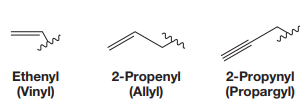
Trivial names such as iso and neo, sec, tert are used to indicate the alkyl groups and their structure as shown below:
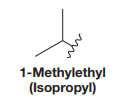
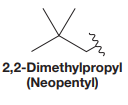
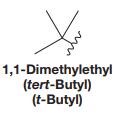
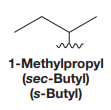
The root names of ketones are derived from those of the parent
Answer to Problem E.23P
The correct IUPAC name for the given trivial name

Explanation of Solution
The name for the given molecule is

The prefix di represents that there are two vinyl groups attached to the carbonyl carbon atom in ketone. Thus, the structure for

While writing the IUPAC name for ketones, the longest continuous carbon chain containing the ketone functional group is to be determined, and it is numbered such that the carbonyl carbon receives the lowest possible numbering. Using this rule, the numbering for the above structure is

The longest continuous carbon chain has five carbon atoms, and the carbonyl carbon is at number 3. Thus, the root name for this will be
The structure of the molecule is drawn and the correct IUPAC name is written for the given trivial name.
(b)
Interpretation:
The structure is to be drawn, and the correct IUPAC name for the given trivial name is to be provided.
Concept introduction:
Ketones consist of two alkyl or aryl groups attached to a carbonyl group, and their trivial names consist of identifying the alkyl or aryl groups and listing them both before the word ketone. Alkyl groups can be alkenes, alkynes, or benzene derivatives. Some of the most common names for alkenes and alkynes are vinyl, allyl, or propargyl. Their structures are as follows:

Trivial names such as iso and neo, sec, tert are used to indicate the alkyl groups and their structure as shown below:




The root names of ketones are derived from those of the parent alkanes, defined by the longest continuous chain of carbon atoms that contains the functional group. For a ketone, drop the -e from the alkane name and add the ending one. To indicate the position of a substituent on a ketone, number the chain in the manner that gives the carbonyl carbon atom the lowest possible locator number. In cyclic ketones, it is understood that the carbonyl carbon atom is C1.
Answer to Problem E.23P
The correct IUPAC name for the given trivial name
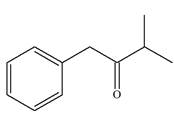
Explanation of Solution
The name for the given molecule is

While writing the IUPAC name for ketones, the longest continuous carbon chain containing the ketone functional group is to be determined, and it is numbered such that the carbonyl carbon receives the lowest possible numbering. Using this rule, the numbering for the above structure is
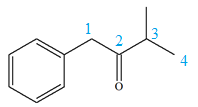
The longest continuous carbon chain has four carbon atoms, and the carbonyl carbon is at number 2. Thus, the root name for this will be
The structure of the molecule is drawn, and the correct IUPAC name is written for the given trivial name.
(c)
Interpretation:
The structure is to be drawn, and the correct IUPAC name for the given trivial name is to be provided.
Concept introduction:
Ketones consist of two alkyl or aryl groups attached to a carbonyl group, and their trivial names consist of identifying the alkyl or aryl groups and listing them both before the word ketone. Alkyl groups can be alkenes, alkynes, or benzene derivatives. Some of the most common names for alkenes and alkynes are vinyl, allyl, or propargyl. Their structures are as follows:

Trivial names such as iso and neo, sec, tert are used to indicate the alkyl groups and their structure as shown below:




The root names of ketones are derived from those of the parent alkanes, defined by the longest continuous chain of carbon atoms that contains the functional group. For a ketone, drop the -e from the alkane name and add the ending one. To indicate the position of a substituent on a ketone, number the chain in the manner that gives the carbonyl carbon atom the lowest possible locator number. In cyclic ketones, it is understood that the carbonyl carbon atom is C1.
Answer to Problem E.23P
The correct IUPAC name for the given trivial name
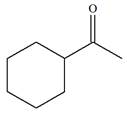
Explanation of Solution
The name for the given molecule is

While writing the IUPAC name for ketones, the longest continuous carbon chain containing the ketone functional group is to be determined, and it is numbered such that the carbonyl carbon receives the lowest possible numbering. Using this rule, the numbering for the above structure is
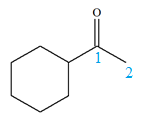
The longest continuous carbon chain has two carbon atoms, and the carbonyl carbon is at number 1. Thus, the root name for this will be
The structure of the molecule is drawn, and the correct IUPAC name is written for the given trivial name.
(d)
Interpretation:
The structure is to be drawn, and the correct IUPAC name for the given trivial name is to be provided.
Concept introduction:
Ketones consist of two alkyl or aryl groups attached to a carbonyl group, and their trivial names consist of identifying the alkyl or aryl groups and listing them both before the word ketone. Alkyl groups can be alkenes, alkynes, or benzene derivatives. Some of the most common names for alkenes and alkynes are vinyl, allyl, or propargyl. Their structures are as follows:

Trivial names such as iso and neo, sec, tert are used to indicate the alkyl groups and their structure as shown below:




The root names of ketones are derived from those of the parent alkanes, defined by the longest continuous chain of carbon atoms that contains the functional group. For a ketone, drop the -e from the alkane name and add the ending one. To indicate the position of a substituent on a ketone, number the chain in the manner that gives the carbonyl carbon atom the lowest possible locator number. In cyclic ketones, it is understood that the carbonyl carbon atom is C1.
Answer to Problem E.23P
The correct IUPAC name for the given trivial name
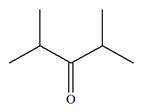
Explanation of Solution
The name for the given molecule is

There is no other substituent present; thus, the structure for the compound is

While writing the IUPAC name for ketones, the longest continuous carbon chain containing the ketone functional group is to be determined, and it is numbered such that the carbonyl carbon receives the lowest possible numbering. Using this rule, the numbering for the above structure is
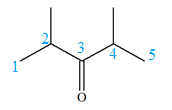
The longest continuous carbon chain has five carbon atoms, and the carbonyl carbon is at number 3. Thus, the root name for this will be
The structure of the molecule is drawn, and the correct IUPAC name is written for the given trivial name.
(e)
Interpretation:
The structure is to be drawn, and the correct IUPAC name for the given trivial name is to be provided.
Concept introduction:
Ketones consist of two alkyl or aryl groups attached to a carbonyl group, and their trivial names consist of identifying the alkyl or aryl groups and listing them both before the word ketone. Alkyl groups can be alkenes, alkynes, or benzene derivatives. Some of the most common names for alkenes and alkynes are vinyl, allyl, or propargyl. Their structures are as follows:

Trivial names such as iso and neo, sec, tert are used to indicate the alkyl groups and their structure as shown below:




The root names of ketones are derived from those of the parent alkanes, defined by the longest continuous chain of carbon atoms that contains the functional group. For a ketone, drop the -e from the alkane name and add the ending one. To indicate the position of a substituent on a ketone, number the chain in the manner that gives the carbonyl carbon atom the lowest possible locator number. In cyclic ketones, it is understood that the carbonyl carbon atom is C1.
Answer to Problem E.23P
The correct IUPAC name for the given trivial name

Explanation of Solution
The name for the given molecule is

There is no other substituent present; thus, the structure for the compound is
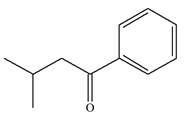
While writing the IUPAC name for ketones, the longest continuous carbon chain containing the ketone functional group is to be determined, and it is numbered such that the carbonyl carbon receives the lowest possible numbering. Using this rule, the numbering for the above structure is
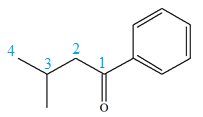
The longest continuous carbon chain has four carbon atoms, and the carbonyl carbon is at number 1. Thus, the root name for this will be
The structure of the molecule is drawn, and the correct IUPAC name is written for the given trivial name.
Want to see more full solutions like this?
Chapter E Solutions
EBK ORGANIC CHEMISTRY: PRINCIPLES AND M
- please provide the structure for this problem, thank youarrow_forwardpresented by Morallen Lig Intermine the hand product for the given mution by adding atoms, bonds, nonhonding diarion panda скуль Step 3: Comp the draw the product Step 2: Agama workup Compithe 429 ملولةarrow_forwardReaction A 0,0arrow_forward
- presented by Morillon Leaning Predict the organic product for the min кусур HSC Adithane carved arnown to come than that to the condon slchroruis in acid in in aquishri with ноюarrow_forward6.15PM Sun Mar 30 K Draw the major product of this reaction. Include any relevant stereochemistry. Ignore inorganic byproducts. Problem 1 of O H [PhзPCH2CH3]*C|¯ NaH Drawing > Q Atoms, Bonds and Draw or tap a nearrow_forward8:17 PM Sun Mar 30 Draw the major product of this reaction. Ignore inorganic byproducts. HSCH2CH2CH2SH, BF3 Probler Drawing Ato Bonds Clarrow_forward
- Name the major organic product of the following action of 4-chloro-4-methyl-1-pentanol in neutral pollution 10+ Now the product. The product has a molecular formula f b. In a singly hain, the starting, material again converts into a secule with the molecular kormula CIO. but with comply Draw the major organic structure inhalationarrow_forwardMacmillan Learning Alcohols can be oxidized by chromic acid derivatives. One such reagent is pyridinium chlorochromate, (C,H,NH*)(CICTO3), commonly known as PCC. Draw the proposed (neutral) intermediate and the organic product in the oxidation of 1-butanol by PCC when carried out in an anhydrous solvent such as CH₂C₁₂. PCC Intermediate OH CH2Cl2 Draw the intermediate. Select Draw Templates More с H Cr о Product Draw the product. Erase Select Draw Templates More H о Erasearrow_forwardIf I have 1-bromopropene, to obtain compound A, I have to add NaOH and another compound. Indicate which compound that would be. A C6H5 CH3arrow_forward
 Chemistry for Today: General, Organic, and Bioche...ChemistryISBN:9781305960060Author:Spencer L. Seager, Michael R. Slabaugh, Maren S. HansenPublisher:Cengage Learning
Chemistry for Today: General, Organic, and Bioche...ChemistryISBN:9781305960060Author:Spencer L. Seager, Michael R. Slabaugh, Maren S. HansenPublisher:Cengage Learning Organic Chemistry: A Guided InquiryChemistryISBN:9780618974122Author:Andrei StraumanisPublisher:Cengage Learning
Organic Chemistry: A Guided InquiryChemistryISBN:9780618974122Author:Andrei StraumanisPublisher:Cengage Learning Organic And Biological ChemistryChemistryISBN:9781305081079Author:STOKER, H. Stephen (howard Stephen)Publisher:Cengage Learning,
Organic And Biological ChemistryChemistryISBN:9781305081079Author:STOKER, H. Stephen (howard Stephen)Publisher:Cengage Learning, General, Organic, and Biological ChemistryChemistryISBN:9781285853918Author:H. Stephen StokerPublisher:Cengage LearningChemistry: Matter and ChangeChemistryISBN:9780078746376Author:Dinah Zike, Laurel Dingrando, Nicholas Hainen, Cheryl WistromPublisher:Glencoe/McGraw-Hill School Pub Co
General, Organic, and Biological ChemistryChemistryISBN:9781285853918Author:H. Stephen StokerPublisher:Cengage LearningChemistry: Matter and ChangeChemistryISBN:9780078746376Author:Dinah Zike, Laurel Dingrando, Nicholas Hainen, Cheryl WistromPublisher:Glencoe/McGraw-Hill School Pub Co Chemistry: Principles and PracticeChemistryISBN:9780534420123Author:Daniel L. Reger, Scott R. Goode, David W. Ball, Edward MercerPublisher:Cengage Learning
Chemistry: Principles and PracticeChemistryISBN:9780534420123Author:Daniel L. Reger, Scott R. Goode, David W. Ball, Edward MercerPublisher:Cengage Learning





